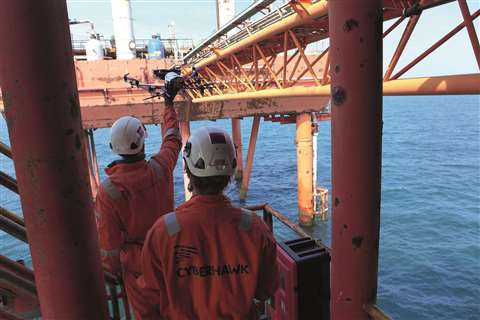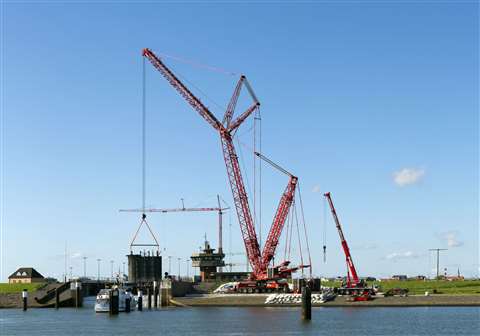Crane technology: Technology at the top
08 October 2019
Joe Sargent looks at how new technology is impacting on machines still based on the same fundamental principles as they were two millenniums ago

Powerful machines with great capacity for lifting, cranes are the musclebound giants of the job site. A casual observer could be forgiven for thinking there’s not much more to them than brute strength and a long reach, but with heavy weights being suspended over working sites, safety is king.
The world of cranes is changing; new age technology is tearing up the paper lift plans of old and replacing them with digital procedures generated in computer programmes. Working with suspended loads has never been safer.
At the Bauma 2019 trade show, Original Equipment Manufacturers (OEMs) showcased state-of-the art fleet management capabilities through telematics, alongside control and training systems, aimed at keeping operators and rental companies at the top of their game.
An area that has long been a subject for discussion are machines that can drive themselves – in this case – the autonomous crane. According to French crane anti-collision expert SMIE, the likelihood of this idea becoming a reality is now one step closer.
Human error

Setting out to eliminate human error, the company conducted multiple tests on a machine using an adapted version of its ProSite anti-collision and jobsite monitoring system. SMIE said that, in a series of tests undertaken during the first quarter of 2019, the system demonstrated great potential for pushing the industry closer to effective crane automation.
When using the system, SMIE believes crane operators will be able to simply select a location and instruct the crane to automatically move to that location without requiring any manual operation. These movements would also be configurable and managed remotely from any connected location, removing the need to climb multiple cranes to make simple parameter changes.
SMIE says that the technology highlights the significant shift taking place within the building and construction industries, from manual processes to automation. The company’s CEO, Jean-Charles Delplace, said, “Digitally supported solutions are becoming an increasingly vital aspect of site safety and efficiency, and are expected to completely transform the sector.”
Challenging conditions

Though fully autonomous cranes could supply some relief in the future, the industry’s skills shortage is a very real problem today. Japanese manufacturer Kobelco is pushing forward with its research and development as it attempts to create what it calls “the jobsite for anyone.”
Kobelco believes that, as a crane manufacturer, its focus should be to eliminate the challenging conditions which arise in lift operations. OEMs, according to Kobelco, need to find a way to enable efficient work on the construction site in order to cope with a decline in the number of skilled technical workers.
Kobelco is currently developing technology that will deliver safety improvements, while potentially saving on labour costs associated with the assembly of crawler cranes. Today these tasks require a large amount of human involvement and experience.
The company has been working on a concept project that will allow the remote control of machines from anywhere in the world. The K-Dive initiative, currently in the testing phase, would see fifth generation (5G) network connectivity facilitate the operation of site machinery while operators sit in an office-like environment.
The testing has so far only been demonstrated on excavators, but it is a principle design that could be implemented with various types of equipment, including cranes. In order for the operator to see what is going on at the site, cameras would be positioned around the machine to give the operator a live feed of the work, straight to their monitors.
Aerial assessments

Another area in the crane segment which is increasingly involving the use of cameras is aerial inspections. Drones, also known as unmanned aerial vehicles (UAVs) are fast becoming key tools for checking the structural integrity of working cranes. These tools not only make access to machinery in hard to reach places easier, they also make it safer.
Drone technology company, Cyberhawk has proven not just the capabilities of drones, but also their necessity in testing conditions, such as inspecting offshore lattice luffing jib-cranes on oil rigs. Rigging cranes is one of the most dangerous tasks associated with the industry. Falls from height are not uncommon and using these airborne gadgets helps keep staff on the ground in a safer surveying environment.
Talking about on-board surveying technology in more detail, data specialist Texo DSI says it has been working in the construction industry to maximise the operational benefits of the drone in inspections.
The company has been installing high-definition 3D laser scanning, combined with UAV imagery and modelling which is said to allow the seamless capture and monitoring
of construction progress, allowing the construction of 3D imagery at each stage. In the last few months it has deployed in-flight focus functionality on its 100MP (Mega Pixel) high resolution aerial metric cameras. This allows lenses to be focused while in-flight, enabling a number of new uses for inspection applications where the focusing distance can be carried out in real time.
Tower crane tests

The role that drones could potentially play in inspecting tower cranes is also an area being explored by Terra Drone Europe. The company is one of the largest drone specialists in the world with around 250 staff working in 15 countries. The company has experience of providing visual and other inspections of structures in the oil and gas sector – both on and offshore – as well as wind turbines and other onshore industrial structures.
One recent project was to carry out inspections on structural steel on offshore platforms with a view to extending their working lives. The possibilities of tower crane inspection have now come to their attention, and the company is keen to explore this sector.
Patrick Rickerby, technical director of Terra Drone Europe said, “High quality photography coupled with computer analysis techniques can help identify defects in steel… Drones may not be able to replace all traditional means of inspecting and maintaining tower cranes, but they can certainly help tower crane owners in their operations.”
SIM-ple operation

US-based simulator experts CM labs has designed a flat-top tower crane simulator. The company say that this will enable an operator in training to learn the fundamentals of standard top-slewing tower crane work, including load charts, blind lifts, and operation with 2-part or 4-part rope configurations set on the hook block.
Using a simulator for training enables the operator to learn in on-the job type conditions while not being a danger to anyone on the jobsite. When using CM labs’ training programme, the time taken to complete tasks are recorded, as well as the number of collisions with the hook, how smooth the operator is performing and whether or not an operator would pass a test based on their performance.
Liebherr has also been developing a new e-learning program aiming to make access to its theory training easier. It hopes this will facilitate the greater take-up of theory training and therefore, through increased understanding, increase the safety of crane operations around the world and possibly even establish an international theory training industry-standard in the process.
“We found that some mobile crane operators knew how to operate a crane but they didn’t necessarily understand exactly what they were doing or why they were doing it,” explains Sascha Brenner, head of training at Liebherr. “We wanted to address this problem directly with the development of our e-learning program.”
To achieve this Liebherr collaborated with e-learning production company Krassmann Produktion and lawyer Dr. Rudolf Saller to create an 18-chapter cloud-based program covering all aspects of mobile crane theory. The program is not Liebherr-specific, so the lessons learnt can be applied by all crane operators, whatever crane make they are using. Being online also means the program can be accessed from anywhere in the world, at a time convenient to the user.
Each chapter takes between 20 minutes to one hour to complete, depending on how fast the person taking it is. On average the whole course takes between 18 to 20 hours to complete, says Liebherr.
Brain training

Building on the theme of operator improvement, technology specialists at Trimble have announced that the company is collaborating with brain-computer interface (BCI) software developer Neurable. The two firms are set on developing BCI technology for solutions that could benefit crane operator training programmes. According to Trimble, Neurable’s technology can provide hands-free and voice-free interactions, as well as cognitive analytics on behaviour for insight-driven and data rich immersive experiences.
The science behind the scheme will measure and adapt to bio signals, such as brain activity combined with eye tracking technology, to improve training efficiency, driver safety and high-risk front-line worker safety.
“Collaborating with Neurable is another step forward in our mission to transform the way our customers consume, interact and communicate information,” said Aviad Almagor, director of the Mixed Reality Program at Trimble. “A new interaction paradigm is required to efficiently merge the digital and physical environments. We believe that BCI technology can play a major role in achieving this future.”
Whatever the future of the crane industry, you can be sure that working with these machines will only get safer and more efficient, and that these machines will remain an integral part of the construction site.
Pulling the strings
Australian specialist develops load system, eliminating taglines

Australia-based lifting and rotation management specialist Verton has developed a new crane safety device which it calls the R-series. The R-series is a remote load-management system that eliminates the need for human held taglines to control suspended loads. This means that for crane operators and those on the ground, safety and productivity are improved.
With greater control of the load from inside the crane, the need for two workers directing the load from the ground is reduced. Verton’s founder and CTO, Stanley Thomson, said, “While also significantly improving safety, the implementation of the R-series will save worksites millions of dollars over its lifetime with payback possible within a year.”
The R-Series is available in various models and can handle loads of up to 20 tonnes, though Verton has also developed solutions that can work with weight up to 400 tonnes. The equipment is operated through an industrial remote control with cameras to livestream the operation. All R-Series models connect to smart software which interprets real-time load movement. Live metrics help with decision making on site with stored data informing future efficiencies and benchmarking.
Verton received funding from the Queensland government’s Business Development Fund (BDF), and the R-series also won a ‘best in class’ award in the engineering design category of Australia’s Good Design Awards.
Manitowoc’s new configurator
Manufacturer has released a free boom configurator app

Manitowoc Cranes has announced a new smartphone app for iOS and Android devices that will help crane operators and owners to quickly determine the overall boom and jib length combination required for a lift.
The Manitowoc Boom Length Selector App allows users to input site information such as building heights, boom radii and other parameters using a sliding scale to determine the basic crane setup required for a specific lift.
John Alexander, director of all-terrain crane service, mobile training and telematics at Manitowoc, said, “By simply entering a few details, the app immediately generates a setup for that specific lift. It is a great tool to use during pre-planning or on site to get the job done.”



